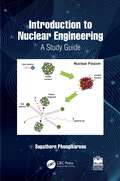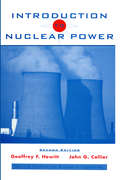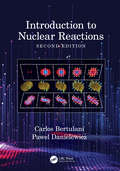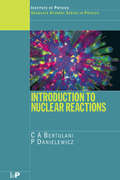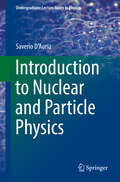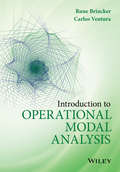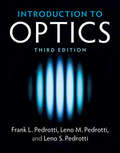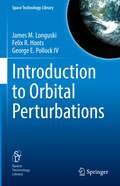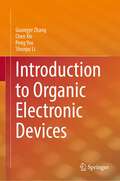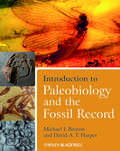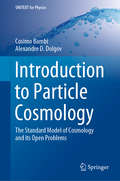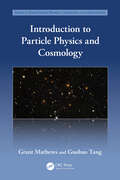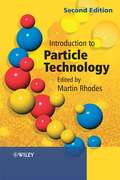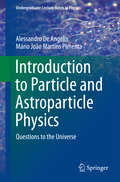- Table View
- List View
Introduction to Nuclear Engineering: A Study Guide
by Supathorn PhongikaroonIntroduction to Nuclear Engineering serves as an accompanying study guide for a complete, introductory single-semester course in nuclear engineering. It is structured for general class use, alongside fundamental nuclear physics and engineering textbooks, and it is equally suited for individual self-study.The book begins with basic modern physics with atomic and nuclear models. It goes on to cover nuclear energetics, radioactivity and decays, and binary nuclear reactions and basic fusion. Exploring basic radiation interactions with matter, the book finishes by discussing nuclear reactor physics, nuclear fuel cycles, and radiation doses and hazard assessment. Each chapter highlights basic concepts, examples, problems with answers, and a final assessment.The book is intended for first-year undergraduate and graduate engineering students taking Nuclear Engineering and Nuclear Energy courses.
Introduction to Nuclear Power
by Geoffrey F. Hewitt John G. CollierThe authors of this text aim to educate the reader on nuclear power and its future potential. It focuses on nuclear accidents such as Chernobyl and Three Mile Island, and their consequences, with the understanding that there are safety lessons to be learned if nuclear power generation is going to be expanded to meet our growing energy needs.
Introduction to Nuclear Reactions
by Carlos Bertulani Pawel DanielewiczUntil the publication of the first edition of Introduction to Nuclear Reactions in 2004, an introductory reference on nuclear reactions had been unavailable. Now, fully updated throughout, this second edition continues to provide an authoritative overview of nuclear reactions. It discusses the main formalisms, ranging from basic laws to the final formulae used in academic research to calculate measurable quantities. Well known in their fields, the authors begin with a basic introduction to elements of scattering theory followed by a study of its applications to specific nuclear reactions. Early chapters give a framework of compound nucleus formation and its decay, fusion, fission, and direct reactions, that can be easily understood by the novice. These chapters also serve as prototypes for applications of the underlying physical ideas presented in previous chapters. The largest section of the book comprises the physical models that have been developed to account for the various aspects of nuclear reaction phenomena, including reactions in stellar environments, cosmic rays, and during the big bang. The final chapters survey applications of the eikonal wavefunction and of nuclear transport equations to nuclear reactions at high energies. By combining a thorough theoretical approach with applications to recent experimental data, Introduction to Nuclear Reactions helps you understand the results of experimental measurements rather than describe how they are made. A clear treatment of the topics and coherent organization make this information understandable to students and professionals with a solid foundation in physics as well as to those with a more general science and technology background. Features: Analyses in detail different models of the nucleus and discusses their interrelations. Fully updated throughout, with new sections and additional discussions on stellar evolution, big bang nucleosynthesis, neutron stars and relativistic heavy ion collisions. Discusses the latest developments in nuclear reaction theory and experiments and explores both direct reaction theories and heavy ion reactions, which are newly important to nuclear physics in reactions with rare nuclear isotopes.
Introduction to Nuclear Reactions (Graduate Student Series in Physics)
by C. A. Bertulani P. DanielewiczUntil the publication of Introduction to Nuclear Reactions, an introductory reference on nonrelativistic nuclear reactions had been unavailable. Providing a concise overview of nuclear reactions, this reference discusses the main formalisms, ranging from basic laws to the final formulae used to calculate measurable quantities.Well known in their fields, the authors begin with a discussion of scattering theory followed by a study of its applications to specific nuclear reactions. Early chapters give a framework of scattering theory that can be easily understood by the novice. These chapters also serve as an introduction to the underlying physical ideas. The largest section of the book comprises the physical models that have been developed to account for the various aspects of nuclear reaction phenomena. The final chapters survey applications of the eikonal wavefunction to nuclear reactions as well as examine the important branch of nuclear transport equations.By combining a thorough theoretical approach with applications to recent experimental data, Introduction to Nuclear Reactions helps you understand the results of experimental measurements rather than describe how they are made. A clear treatment of the topics and coherent organization make this information understandable to students and professionals with a solid foundation in physics as well as to those with a more general science and technology background.
Introduction to Nuclear Reactor Experiments
by Cheol Ho Pyeon Genichiro Wakabayashi Takahiro Yamada Tomohiro EndoThis open access book is a pedagogical text on nuclear reactor experiments, covering almost all the experiments that can be carried out at the University Training Reactor, Kindai University (UTR-KINKI) with respect to reactor physics and radiation detection, and additionally including academic materials of test and research reactors, nuclear instrumentation, nuclear laws and regulations, in this main body. The book is an excellent primer for students who are interested in reactor physics, radiation detection, nuclear laws and regulations at universities, and the best textbook for students who have started to study the nuclear energy related fields to understand the basic theories and principles of the experiments in the fields of reactor physics and radiation detection. UTR-KINKI has been used for educational reactor experiments and basic research in a wide range of fields related to the use of radiation (neutrons, gamma-ray, beta-ray, alpha-ray, and X-ray), including reactor physics, radiation detection, radiation health physics, activation analysis, radiation biology, medical applications and archaeology. Also, UTR-KINKI has been actively engaged in nuclear education with its long history of operation, and has gained extensive experience in educational activities for undergraduate and graduate students, elementary, junior high and high school teachers, junior high and high school students, and general audiences.
Introduction to Nuclear Reactor Physics
by Robert E. MastersonINTRODUCTION TO NUCLEAR REACTOR PHYSICS is the most comprehensive, modern and readable textbook for this course/module. It explains reactors, fuel cycles, radioisotopes, radioactive materials, design, and operation. Chain reaction and fission reactor concepts are presented, plus advanced coverage including neutron diffusion theory. The diffusion equation, Fisk’s Law, and steady state/time-dependent reactor behavior. Numerical and analytical solutions are also covered. The text has full color illustrations throughout, and a wide range of student learning features.
Introduction to Nuclear Science
by Jeff C. BryanThis book was written to provide students who have limited backgrounds in the physical sciences and math with an accessible textbook on nuclear science. Expanding on the foundation of the bestselling first edition, Introduction to Nuclear Science, Second Edition provides a clear and complete introduction to nuclear chemistry and physics, from basic
Introduction to Nuclear Science
by Jeff C. BryanWritten to provide students who have limited backgrounds in the physical sciences and math with an accessible textbook on nuclear chemistry and physics, Introduction to Nuclear Science, Fourth Edition continues to provide a clear and complete introduction to nuclear chemistry and physics, from basic concepts to nuclear power and medical applications. Incorporating suggestions from adopting professors and collaborations with the U.S. Department of Energy-funded and American Chemical Society-sponsored Nuclear Chemistry Summer School, a new chapter on nuclear structure is now included. Also new to this edition: A section covering mass excess calculations Isochron dating of rocks The section on statistics is completely re-written to better align with conventional instruction Expanded discussion of recent changes in the nuclear power industry and nuclear medicine This book covers energetics, nuclear stability and structure, radioactive decay and reactions, interactions of radiation with matter, detection methods, and safety measures, including monitoring and regulations. This updated, expanded edition provides a much-needed textbook and resource for undergraduate students in science and engineering as well as those studying nuclear medicine and radiation therapy.
Introduction to Nuclear and Particle Physics (Undergraduate Lecture Notes in Physics)
by Saverio D'AuriaThis textbook fills the gap between the very basic and the highly advanced volumes that are widely available on the subject. It offers a concise but comprehensive overview of a number of topics, like general relativity, fission and fusion, which are otherwise only available with much more detail in other textbooks. Providing a general introduction to the underlying concepts (relativity, fission and fusion, fundamental forces), it allows readers to develop an idea of what these two research fields really involve. The book uses real-world examples to make the subject more attractive and encourage the use of mathematical formulae. Besides short scientists' biographies, diagrams, end-of-chapter problems and worked solutions are also included.Intended mainly for students of scientific disciplines such as physics and chemistry who want to learn about the subject and/or the related techniques, it is also useful to high school teachers wanting to refresh or update their knowledge and to interested non-experts.
Introduction to Numerical Electrostatics Using MATLAB
by Lawrence N. DworskyThe first of its kind uniquely devoted to the field of computational electrostatics, this book dives headfirst into the actual problems that engineers are expected to solve using method of moment (MoM), finite difference, and finite element techniques. Readers are guided step by step through specific problems and challenges, covering all aspects of electrostatics with an emphasis on numerical procedures. Focusing on practical examples, mathematical equations, and common issues with algorithms, this is an ideal text for students in engineering, physics, and electrostatics--and working engineers and physicists.
Introduction to Numerical Programming: A Practical Guide for Scientists and Engineers Using Python and C/C++ (Series in Computational Physics)
by Titus A. BeuMakes Numerical Programming More Accessible to a Wider AudienceBearing in mind the evolution of modern programming, most specifically emergent programming languages that reflect modern practice, Numerical Programming: A Practical Guide for Scientists and Engineers Using Python and C/C++ utilizes the author's many years of practical research and tea
Introduction to Operational Modal Analysis
by Rune Brincker Carlos VenturaComprehensively covers the basic principles and practice of Operational Modal Analysis (OMA). Covers all important aspects that are needed to understand why OMA is a practical tool for modal testing Covers advanced topics, including closely spaced modes, mode shape scaling, mode shape expansion and estimation of stress and strain in operational responses Discusses practical applications of Operational Modal Analysis Includes examples supported by MATLAB® applications Accompanied by a website hosting a MATLAB® toolbox for Operational Modal Analysis
Introduction to Optics (3rd Edition): Pearson New International Edition
by Frank L. Pedrotti Leno M. Pedrotti Leno S. PedrottiIntroduction to Optics is now available in a re-issued edition from Cambridge University Press. Designed to offer a comprehensive and engaging introduction to intermediate and upper level undergraduate physics and engineering students, this text also allows instructors to select specialized content to suit individual curricular needs and goals.<P><P> Specific features of the text, in terms of coverage beyond traditional areas, include extensive use of matrices in dealing with ray tracing, polarization, and multiple thin-film interference; three chapters devoted to lasers; a separate chapter on the optics of the eye; and individual chapters on holography, coherence, fiber optics, interferometry, Fourier optics, nonlinear optics, and Fresnel equations.<P> Contains many technical illustrations designed to enhance student understanding.<P> Includes modern applications, such as: liquid crystal displays, CCD's, CD and DVD technology, optical parametric oscillators and amplifiers, near field microscopy, ultra short pulses, manipulation of atoms with lasers (optical tweezers, optical cooling and trapping), selected applications in nanophotonics and biophotonics, extensive treatment of communication systems using optical fibers, and wavelength division multiplexing.<P> Offers an early discussion of lasers, which establishes the importance of the laser as an optical instrument and allows for early introduction of various applications and discussions related to laser operation.
Introduction to Optimization for Chemical and Environmental Engineers
by Louis Theodore Kelly BehanThis book presents the introductory fundamentals of several optimization methods with accompanying practical engineering applications. It examines mathematical optimization calculations common to both environmental and chemical engineering professionals, with a primary focus on perturbation techniques, search methods, graphical analysis, analytical methods, linear programming, and more. The book presents numerous illustrative examples laid out in such a way as to develop the reader’s technical understanding of optimization, with progressively difficult examples located at the end of each chapter. This book serves as a training tool for students and industry professionals alike.
Introduction to Orbital Perturbations (Space Technology Library #40)
by James M. Longuski Felix R. Hoots George E. Pollock IVThis textbook provides details of the derivation of Lagrange's planetary equations and of the closely related Gauss's variational equations, thereby covering a sorely needed topic in existing literature. Analytical solutions can help verify the results of numerical work, giving one confidence that his or her analysis is correct. The authors—all experienced experts in astrodynamics and space missions—take on the massive derivation problem step by step in order to help readers identify and understand possible analytical solutions in their own endeavors. The stages are elementary yet rigorous; suggested student research project topics are provided.After deriving the variational equations, the authors apply them to many interesting problems, including the Earth-Moon system, the effect of an oblate planet, the perturbation of Mercury's orbit due to General Relativity, and the perturbation due to atmospheric drag. Along the way, they introduce several useful techniques such as averaging, Poincaré's method of small parameters, and variation of parameters. In the end, this textbook will help students, practicing engineers, and professionals across the fields of astrodynamics, astronomy, dynamics, physics, planetary science, spacecraft missions, and others. “An extensive, detailed, yet still easy-to-follow presentation of the field of orbital perturbations.” - Prof. Hanspeter Schaub, Smead Aerospace Engineering Sciences Department, University of Colorado, Boulder “This book, based on decades of teaching experience, is an invaluable resource for aerospace engineering students and practitioners alike who need an in-depth understanding of the equations they use.” - Dr. Jean Albert Kéchichian, The Aerospace Corporation, Retired “Today we look at perturbations through the lens of the modern computer. But knowing the why and the how is equally important. In this well organized and thorough compendium of equations and derivations, the authors bring some of the relevant gems from the past back into the contemporary literature.” - Dr. David A Vallado, Senior Research Astrodynamicist, COMSPOC “The book presentation is with the thoroughness that one always sees with these authors. Their theoretical development is followed with a set of Earth orbiting and Solar System examples demonstrating the application of Lagrange’s planetary equations for systems with both conservative and nonconservative forces, some of which are not seen in orbital mechanics books.” - Prof. Kyle T. Alfriend, University Distinguished Professor, Texas A&M University
Introduction to Organic Chemistry
by William H. Brown Thomas PoonIntroduction to Organic Chemistry, 6th Edition provides an introduction to organic chemistry for students who require the fundamentals of organic chemistry as a requirement for their major. It is most suited for a one semester organic chemistry course. In an attempt to highlight the relevance of the material to students, the authors place a strong emphasis on showing the interrelationship between organic chemistry and other areas of science, particularly the biological and health sciences. The text illustrates the use of organic chemistry as a tool in these sciences; it also stresses the organic compounds, both natural and synthetic, that surround us in everyday life: in pharmaceuticals, plastics, fibers, agrochemicals, surface coatings, toiletry preparations and cosmetics, food additives, adhesives, and elastomers.
Introduction to Organic Electronic Devices
by Peng You Guangye Zhang Chen Xie Shunpu LiThis book comprehensively describes organic electronic devices developed in the past decades. It not only covers the mainstream devices including organic light emitting diodes (OLEDs), organic photovoltaics (OPVs), and organic thin-film transistors (OTFTs) but also includes devices of recent interest such as organic immune transistors, organic photocatalysis devices, and themoelectrical devices. The book starts from the introduction of basic theory of organic semiconductor materials and devices, which acquaints the readers with the concepts of each type of device described in the following chapters. It also discusses the working principles, device layout, and fabrication process of these devices. The book is intended for undergraduate and postgraduate students who are interested in organic electronics, researchers/engineers working in the field of organic electronic devices/systems.
Introduction to Organic and Medicinal Chemistry
by Nathan Jack KeighleyThis text is designed to be an undergraduate reference textbook for students of chemistry who aim to select degree modules geared towards medicinal chemistry. The first two chapters offer an overview of basic organic chemistry, followed by organic synthesis in Chapter 3, with an emphasis on the importance of synthetic procedures in relation to the chemistry of drug design. In Chapter 4, the book covers foundational aspects of biochemistry and biomedical science to provide a basis for students understanding where and how drugs work on selected targets. Later, the book explains how medicines have been created for selected topics in medicinal chemistry – namely against pathogens, cancer and neurological targets.Features: User-friendly text that deals with key methods in organic synthesis and medicinal chemistry An overture of drug design against disease targets An introduction to the molecular basis of disease and key topics in medicinal chemistry Geared toward chemistry undergraduates with an interest in pursuing medicinal chemistry further into their degree A complete set of tutorial questions and answers for each chapter
Introduction to Paleobiology and the Fossil Record
by Michael J. Benton David A. HarperThis book presents a comprehensive overview of the science of the history of life. Paleobiologists bring many analytical tools to bear in interpreting the fossil record and the book introduces the latest techniques, from multivariate investigations of biogeography and biostratigraphy to engineering analysis of dinosaur skulls, and from homeobox genes to cladistics. All the well-known fossil groups are included, including microfossils and invertebrates, but an important feature is the thorough coverage of plants, vertebrates and trace fossils together with discussion of the origins of both life and the metazoans. All key related subjects are introduced, such as systematics, ecology, evolution and development, stratigraphy and their roles in understanding where life came from and how it evolved and diversified.Unique features of the book are the numerous case studies from current research that lead students to the primary literature, analytical and mathematical explanations and tools, together with associated problem sets and practical schedules for instructors and students."..any serious student of geology who does not pick this book off the shelf will be putting themselves at a huge disadvantage. The material may be complex, but the text is extremely accessible and well organized, and the book ought to be essential reading for palaeontologists at undergraduate, postgraduate and more advanced levels--both in Britain as well as in North America." Falcon-Lang, H., Proc. Geol. Assoc. 2010"...this is an excellent introduction to palaeontology in general. It is well structured, accessibly written and pleasantly informative .....I would recommend this as a standard reference text to all my students without hesitation." David Norman Geol Mag 2010Companion websiteThis book includes a companion website at: www.blackwellpublishing.com/paleobiologyThe website includes: · An ongoing database of additional Practical's prepared by the authors· Figures from the text for downloading· Useful links for each chapter· Updates from the authors
Introduction to Paleobiology and the Fossil Record
by Michael J. Benton David A. HarperThis book presents a comprehensive overview of the science of the history of life. Paleobiologists bring many analytical tools to bear in interpreting the fossil record and the book introduces the latest techniques, from multivariate investigations of biogeography and biostratigraphy to engineering analysis of dinosaur skulls, and from homeobox genes to cladistics. All the well-known fossil groups are included, including microfossils and invertebrates, but an important feature is the thorough coverage of plants, vertebrates and trace fossils together with discussion of the origins of both life and the metazoans. All key related subjects are introduced, such as systematics, ecology, evolution and development, stratigraphy and their roles in understanding where life came from and how it evolved and diversified. Unique features of the book are the numerous case studies from current research that lead students to the primary literature, analytical and mathematical explanations and tools, together with associated problem sets and practical schedules for instructors and students. New to this edition The text and figures have been updated throughout to reflect current opinion on all aspects New case studies illustrate the chapters, drawn from a broad distribution internationally Chapters on Macroevolution, Form and Function, Mass extinctions, Origin of Life, and Origin of Metazoans have been entirely rewritten to reflect substantial advances in these topics There is a new focus on careers in paleobiology
Introduction to Particle Cosmology
by Cosimo Bambi Alexandre D. DolgovThis book introduces the basic concepts of particle cosmology and covers all the main aspects of the Big Bang Model (expansion of the Universe, Big Bang Nucleosynthesis, Cosmic Microwave Background, large scale structures) and the search for new physics (inflation, baryogenesis, dark matter, dark energy). It also includes the majority of recent discoveries, such as the precise determination of cosmological parameters using experiments like WMAP and Planck, the discovery of the Higgs boson at LHC, the non-discovery to date of supersymmetric particles, and the search for the imprint of gravitational waves on the CMB polarization by Planck and BICEP. This textbook is based on the authors' courses on Cosmology, and aims at introducing Particle Cosmology to senior undergraduate and graduate students. It has been especially written to be accessible even for those students who do not have a strong background in General Relativity and quantum field theory. The content of this book is organized in an easy-to-use style and students will find it a helpful research guide.
Introduction to Particle Cosmology: The Standard Model of Cosmology and its Open Problems (UNITEXT for Physics)
by Cosimo Bambi Alexandre D. DolgovThis book introduces the basic concepts of particle cosmology and covers all the main aspects of the Big Bang Model (expansion of the Universe, Big Bang Nucleosynthesis, Cosmic Microwave Background, large scale structures) and the search for new physics (inflation, baryogenesis, dark matter, dark energy). It also includes the majority of recent discoveries, such as the precise determination of cosmological parameters using experiments like WMAP and Planck, the discovery of the Higgs boson at LHC, the non-discovery to date of supersymmetric particles, and the search for the imprint of gravitational waves on the CMB polarization by Planck and BICEP.This textbook is based on the authors’ courses on Cosmology, and aims at introducing Particle Cosmology to senior undergraduate and graduate students. It has been especially written to be accessible even for those students who do not have a strong background in General Relativity and quantum field theory. The content of this book is organized in an easy-to-use style and students will find it a helpful research guide.
Introduction to Particle Physics and Cosmology (Series in High Energy Physics, Cosmology and Gravitation)
by Grant Mathews Guobao TangThis textbook provides an accessible introduction to the basic concepts of relativistic cosmology and the standard big bang model of cosmology, along with an introduction to quantum field theory and the standard model of particle physics.Readers are guided through the key concepts associated with the standard model of cosmology and the standard model of particle physics, providing them with the basic foundation needed to understand current research and literature on the physics of the early universe and modern particle physics.It culminates with an introduction to the physics of the early universe and its imprint on the large-scale structure and the cosmic microwave background. It assumes a basic understanding of quantum mechanics, classical mechanics and electromagnetism. It is aimed at advanced undergraduates and first year beginning graduate students studying particle physics and/or cosmology.Key Features: Provides a summary of the state-of-the-art tools and developments in cosmology and features end of chapter problems, alongside the basic tools for studies of inflation theory and early-universe cosmology Provides an understandable introduction to special and general relativity Includes an understandable introduction to the standard model of particle physics including group theory, gauge theories, quantum field theory, the Higgs mechanism and the Electroweak Lagrangian
Introduction to Particle Technology
by Martin J. RhodesParticle technology is a term used to refer to the science and technology related to the handling and processing of particles and powders. The production of particulate materials, with controlled properties tailored to subsequent processing and applications, is of major interest to a wide range of industries, including chemical and process, food, pharmaceuticals, minerals and metals companies and the handling of particles in gas and liquid solutions is a key technological step in chemical engineering.This textbook provides an excellent introduction to particle technology with worked examples and exercises. Based on feedback from students and practitioners worldwide, it has been newly edited and contains new chapters on slurry transport, colloids and fine particles, size enlargement and the health effects of fine powders. Topics covered include:Characterization (Size Analysis)Processing (Granulation, Fluidization)Particle Formation (Granulation, Size Reduction)Storage and Transport (Hopper Design, Pneumatic Conveying, Standpipes, Slurry Flow)Separation (Filtration, Settling, Cyclones)Safety (Fire and Explosion Hazards, Health Hazards)Engineering the Properties of Particulate Systems (Colloids, Respirable Drugs, Slurry Rheology)This book is essential reading for undergraduate students of chemical engineering on particle technology courses. It is also valuable supplementary reading for students in other branches of engineering, applied chemistry, physics, pharmaceutics, mineral processing and metallurgy. Practitioners in industries in which powders are handled and processed may find it a useful starting point for gaining an understanding of the behavior of particles and powders.Review of the First Edition taken from High Temperatures - High pressures 1999 31 243 - 251"..This is a modern textbook that presents clear-cut knowledge. It can be successfully used both for teaching particle technology at universities and for individual study of engineering problems in powder processing."
Introduction to Particle and Astroparticle Physics
by Alessandro De Angelis Mário João Martins PimentaThis book, written by researchers who had been professionals in accelerator physics before becoming leaders of groups in astroparticle physics, introduces both fields in a balanced and elementary way, requiring only a basic knowledge of quantum mechanics on the part of the reader. The early history of particle physics cannot be distinguished from the history of cosmic rays. With the advent of accelerators, however, the importance of cosmic rays in particle physics was lost. This situation persisted until the 1990s, when novel techniques allowed breakthrough discoveries, and exploration of new physics scales now requires returning to cosmic rays. The new profile of scientists in fundamental physics ideally involves the merging of knowledge in astroparticle and particle physics, but the duration of modern experiments is such that people cannot simultaneously be practitioners in both. Introduction to Particle and Astroparticle Physics is designed to bridge the gap between the fields. It can be used as a self-training book, a consultation book, or a textbook providing a "modern" approach to particles and fundamental interactions.
